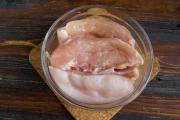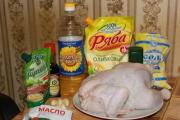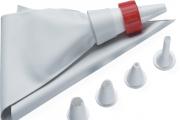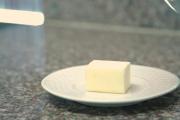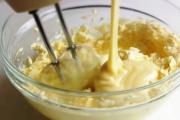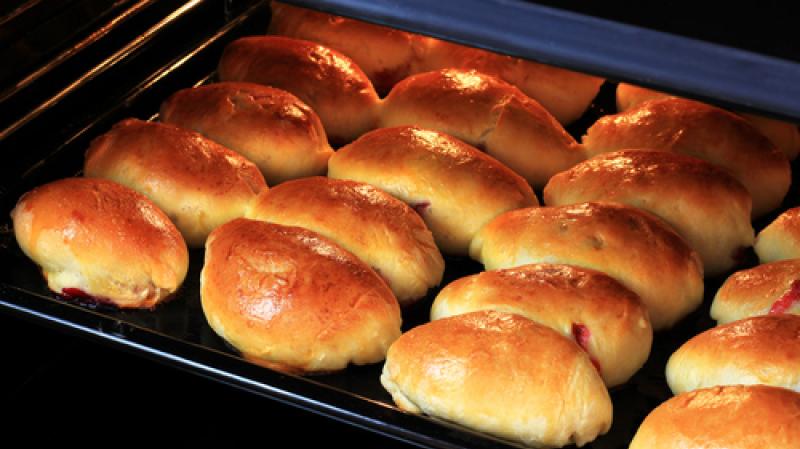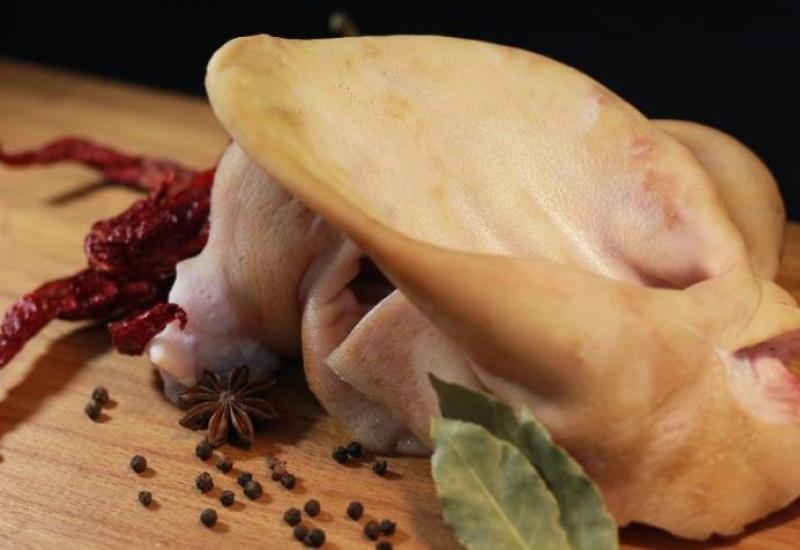Filling for starchy jam pies. Secrets of "non-escaping" fruit filling. The use of agar-agar thickener when cooking jam
Jam pies are a delicious, tender, ruddy delicacy from childhood, so simple and uncomplicated ... Maybe because it immediately reminds of cozy family evenings filled with soulfulness and warmth with long conversations over tea. Several generations of grandmother's favorite pies with jam were gathered at the table at once, so that, following the old Russian tradition, they could “feast” to glory. Time passes, tastes change, but our housewives' desire to bake pies with jam has not disappeared anywhere, just as the taste of this unique, primordially Russian delicacy has not changed either.
The dough for pies is most often made with yeast, although no one bothers to experiment and make pies from unleavened, custard or puff pastry... Any jam for the filling can be used. The main thing is that it is not too liquid, so that the filling does not flow out of the pies - the thicker the better. But if you only have liquid jam, then this situation can be easily corrected by adding a little wheat or corn flour, corn or potato starch, or 1 tbsp. l. oatmeal for 1 glass of jam. You can also add bread crumbs or ground biscuits.
If you decide to use yeast dough, let it come up, then cut into small balls and leave again for a while, so that they come up. After that, roll the balls into flat cakes, put the jam filling in the center of each, shape the pies, let them come up too, and only then grease with a beaten egg and send to the oven preheated to 180-200 ° C. After 20-25 minutes, the jam pies are ready. It's time to put the kettle on the stove and set the table!

Ingredients:
750 g flour
500 ml of milk
8 g dry yeast
50 g sugar
3 eggs,
55 g butter
zest of one orange,
95 ml of vegetable oil,
250 ml raspberry jam.
Preparation:
Combine all dry ingredients. Pour barely warm milk into the dry mixture along with beaten eggs and vegetable oil... Add orange zest to the dough before kneading. Roll an elastic ball out of the dough, cover it and put it in a warm place for 1 hour to come up. Then roll it out, divide it into pieces, roll out a cake from each, put the jam in the center and pinch the edges. Place the pies on a baking sheet, brush with melted butter and bake in an oven preheated to 180 ° C for 30 minutes.
Yeast pies with currant jam in the oven
Ingredients:
For the test:
5 stacks flour,
500 ml of milk
35 g of compressed yeast,
2 eggs,
4 tbsp. l. vegetable oil,
5 tbsp. l. butter,
5 tbsp. l. Sahara,
vanillin, salt - to taste.
For filling:
1 stack. currant jam.
Preparation:
Prepare a dough: dissolve yeast in warm milk, add 1 tbsp. l. sugar and 2 cups sifted flour. The consistency of the dough should resemble thick sour cream. Cover the dough with a towel, place in a warm place and leave for 25 minutes to rise. In the meantime, beat the egg whites into a stable foam, mash the yolks with 1 tbsp. l. sugar to a white airy mass. Add the yolks to the protein mass and mix well. Pour the prepared egg mixture into the matched dough, add vanillin, salt, melted butter and 2 cups of sifted flour. Knead the dough well and season with vegetable oil. Continuing to knead the dough, add a little of the remaining flour, bringing the dough to an elastic state. Leave the finished dough warm for 25-35 minutes, so that it rises well and brightens. Place the dough on a cutting board, roll it into a ball, hit it several times to expel all the air from the yeast mass, dust the dough with flour and let it sit for 7 minutes. Then roll the dough on a table sprinkled with flour into a 1 cm thick layer, cut out circles, put 1 tsp in the center of each. currant jam, pinch the edges well and shape into patties. Place them on a greased baking sheet, grease the top of the patties with beaten egg or vegetable oil and place in an oven preheated to 200 ° C for 30 minutes until golden brown. Cover the finished baked goods with a towel, this will protect them from drying out.

Strawberry jam pies
Ingredients:
500 g flour
250 ml of milk
50 ml of water,
7 g dry yeast,
50 g butter
1 egg,
5 tbsp. l. Sahara,
1-2 tbsp. l. starch
½ tsp salt,
400 g of strawberry jam.
Preparation:
Sift flour, mix it with salt, dry yeast and sugar. Add soft butter to the flour mixture and crush everything into crumbs. Then pour a little milk and water into the flour mixture and continue kneading the dough until it stops sticking to your hands. Cover the finished dough with cling film and leave in a warm place until doubled in volume. Pull back and let it rise again. Knead the dough a little again and leave again to rise. Place the dough on the table, shape it into a sausage, divide it into pieces and let them lie down for a long time. Roll each piece into a flat cake and put the filling in the center - a little jam mixed with starch. Connect the edges of the cakes and form the cakes. Line a baking sheet with baking paper, place the patties, cover with cling film and leave for 30 minutes. Then grease the pies with a slightly beaten egg, send to the oven preheated to 180-200 ° C and bake until golden brown.
Patties with apricot jam and pumpkin
Ingredients:
250 ml of milk
10 g yeast
flour - how much dough will take,
1 tsp Sahara,
1.5 tsp salt,
1 egg,
8 tbsp. l. vegetable oil,
250 g apricot jam,
100 g pumpkin.
Preparation:
Dissolve yeast in milk, add sugar and leave for 5-7 minutes. Then add salt, vegetable oil, flour to the mass, knead a non-steep dough, put it in a plastic bag and leave for 40 minutes. In the meantime, heat the apricot jam, if it's runny, add a little starch to it and reheat. If the jam is thick, then you don't need to do this. Grate the pumpkin on a fine grater and add to the jam, boil everything together for 5 minutes and cool. Lightly wrap the dough that has come up, divide it into equal balls and shape into patties. Line a baking sheet with parchment and place the patties seam side down. Let them lie on a baking sheet for a while, then brush with an egg, send to the oven, preheated to 180 ° C, and bake until tender.
Pies with pear jam and walnuts
Ingredients:
butter yeast dough (prepared in any way you are used to),
300-400 g of pear jam,
100-150 g of walnuts,
3 strips of orange peel
45 ml of milk.
Preparation:
Knead the yeast dough in any way you like and let it sit. To prepare the filling, combine the grated orange zest with pear jam and chopped walnuts. Then heat this mixture over medium heat until boiling and cool. Form the patties, place on the covered parchment paper baking sheet, grease the surface of the pies with milk and send to the oven, preheated to 180 ° C, bake until browning.

Fried pies with strawberry jam on kefir
Ingredients:
500-700 g flour
500 ml of kefir,
2 eggs,
½ stack. Sahara,
50 g yeast
1 pinch of salt
Preparation:
Combine eggs, sugar, kefir, salt and yeast and whisk. Then, gradually adding flour, knead a homogeneous dough. Leave it in a cool place for a few hours for it to come up. Shape the patties. Pour a small amount of vegetable oil into the pan, gradually lay out the pies and fry them on all sides until golden brown. Put the finished pies on paper towels to remove excess oil.
Puff pastries with cherry jam
Ingredients:
1 pack of ready-made yeast puff pastry,
Cherry jam,
1 egg,
a little flour - for sprinkling the table.
Preparation:
Sprinkle flour on the table surface and roll out the dough thinly, cut it into rectangles with a knife. Put the jam berries on one edge of the dough rectangles, cover the filling with the second half of the dough. Pin the edges together with the teeth of a fork and place the patties on a baking sheet lined with parchment paper. Grease the top of the patties with a beaten egg and bake in an oven preheated to 180-200 ° C for 20 minutes until golden brown.
Pies from curd dough with jam
Ingredients:
700 g flour
500 g of cottage cheese,
3 eggs,
1 stack. vegetable oil,
1 stack. Sahara,
3 sachets (10 g each) baking powder,
1 bag of vanilla sugar
any jam.
Preparation:
Combine all the ingredients and knead into an elastic dough that does not stick to your hands and remains soft. Leave the finished dough to stand for 2 hours in a warm place. Divide the dough into pieces and shape into patties. Place on a baking sheet lined with baking paper, brush with egg yolk and send in an oven preheated to 180 ° C for 20 minutes until golden brown.
Pumpkin Pastry Nut Jam Patties
Ingredients:
600 g flour
300 g pumpkin puree
2 eggs,
1 sachet of dry yeast,
3 tbsp. l. milk,
60 g butter
2 tbsp. l. honey,
½ tsp salt.
For filling:
500 ml of green walnut jam (it can be replaced with cherry, pear, quince), but that will be a completely different story.
Preparation:
Grate the pumpkin with a fine grater. Drain the syrup from the jam. To make pumpkin dough, mix ⅓ flour, pumpkin puree, honey, salt, 1 egg and 1 protein, yeast and milk. Stir, add melted butter and ⅓ more flour, stirring occasionally. Knead an elastic dough, cover it with a towel and place in a warm place for 2 hours. Knead the risen dough, adding the remaining flour. Make tortillas out of the dough and shape into patties. Put on a baking sheet covered with parchment paper and oiled, let them stand for 10-15 minutes, brush with egg yolk, beaten with 1 tsp. milk, and place in an oven preheated to 200 ° C for 20-25 minutes.

Yeast fried pies with apple jam
Ingredients:
For the test:
5 stacks flour,
20 g of regular yeast or 1 tbsp. l. dry (optional),
5 tbsp. l. vegetable oil,
500 ml of milk
2 tbsp. l. Sahara,
a pinch of salt,
vegetable oil - for frying.
For filling:
homemade apple jam.
Preparation:
Combine vegetable oil, yeast, salt and sugar, add warm milk and, while stirring, gradually add flour. Put the resulting viscous dough in a bag and refrigerate for 40 minutes. Sprinkle the surface of the table with flour, lay out the dough, sprinkle with flour and smooth with your hands. Using a cup, cut out the circles, place the apple filling in the center of each circle, pinch the edges and shape into patties. Fry the pies in a frying pan with vegetable oil, over low heat, under the lid, so that they bake well and turn out fluffy and ruddy.
Viennese jam pies
Ingredients:
400 g flour
100 g sugar
8 egg yolks
200 g butter
100 g of semi-sweet wine,
200 g of sour jam,
cinnamon and powdered sugar to taste.
Ingredients:
Remove the butter from the refrigerator, let it stand for 10-15 minutes, then cut into slices. Sift flour and grind it with butter until fine crumbs, add egg yolks, and then all the other ingredients, knead into a homogeneous dough that does not stick to your hands. Roll the finished dough into a sausage and cut into small pieces. Roll each piece of dough into a not very thin strip, brush each piece with melted butter and stack one on top of the other. Wrap a stack of strips in plastic wrap and refrigerate for 2 hours. Then roll out this structure approximately 0.3 cm thick and cut out circles, which can also be rolled out slightly. Place a little jam filling in the center of each mug (ideally in this case, jam from black currant) and mold the pies by folding the filled mugs in half. Pinch the edges carefully and place not too close together on a greased baking sheet. Bake in an oven preheated to 200 ° C for 15-20 minutes. When they have cooled slightly, sprinkle with cinnamon and powdered sugar.
Bon appetit and new culinary discoveries!
Larisa Shuftaykina
Many housewives at least once faced the problem of “running away” and burning sweet filling. The bottom of the pies is blurred from it, and the baking trays are then very difficult to wipe off. All this spoils the result of baking, nullifies all efforts. Some even completely refuse to use it, so as not to waste their nerves and not to spoil the mood.
How do you make your pastries delicious, with plenty of sweet filling that behaves perfectly? There are a few tricks you can use to achieve the desired result.
Making the jam thicker
To prevent the filling from flowing out of the pies, you can specially thicken the jam or jam in several ways:
- boil a little, adding a small amount of semolina (1 teaspoon per glass);
- the filling will certainly thicken if you put powdered fruit or berry jelly in it (again, a teaspoon per glass);
- an old effective way is to add a little of any starch;
- flour, oatmeal, bread crumbs, ground dry biscuits will serve perfectly for the same purposes;
- you can make jam or confiture yourself, specially thickening it with gelatin.
Tricks of Cooking Pies
To prevent the bottom of the pie from getting wet from the wet filling, you can sprinkle the berries on top with flour from ground oatmeal. The oatmeal will not affect the taste of the baked goods and will absorb excess liquid.
You can even cover the rolled dough with a thin layer of starch, ground crackers, gelatin before spreading the filling. Then lay out the berry layer and repeat the sprinkling on top.
Fruit is best spread with the skin down and sprinkled with sugar on top. This applies to peaches, apricots, small pears, apples, plums.
Alternatively, raisins, dried apricots, and prunes added to fruit also do a good job with excess liquid. But there is one nuance, they must be washed, but not soaked, and not overdried.
Fresh cherries can be juiced, sprinkled with sugar and left for a while. The juice that appears is drained, and the berry is ready to be placed in the product. It will not be superfluous to sprinkle it with starch in the end.
Apples pre-baked without the skin will make a wonderful, non-wet filling and absolutely no hassle.
All fruits will give up some of the moisture if they are boiled a little beforehand.
If the buns, conceived with pieces of fruit, end up without them at the end of baking, then to prevent this from happening, the fruit should be rolled in starch or flour before adding.
Maybe you shouldn't cut it in the heat and give up sweet pastries with berries and fruits? Try it again and see that such fillings can bring aesthetic and gustatory pleasure!
Pie stuffed with fresh apples
Cooking tricks for fruit fillings.
So that the filling does not flow out of the jam.
To prevent the fruit cake from getting wet from the filling.
Wet fillings - jam, jam, fresh fruit often create problems for newcomers to the kitchen: jam filling flows out, fruit pie becomes wet from excess juice and looks unbaked.
The simplest solution is to put less filling. Not everyone will like it, it tastes better when there are a lot of fillings. In addition, if the fruit is very juicy, the pie gets wet even from a small amount of filling.
Another solution is to thicken the filling with a product that absorbs moisture. It is advisable that this product does not impose its own taste.
There can be no exact recipe for the amount of filler, since the jam used for the filling can be of different thicknesses, and the quality of filler products today differ from different manufacturers.
Usually housewives find their method empirically.
So that the filling does not flow out of the jam, jam or jam, they do this:
- boil the jam in advance, add semolina to it. On average, 1 teaspoon or 1 tablespoon per glass of jam, the amount of semolina depends on the thickness of the jam or jam. Cool the mass, it will thicken and will not flow out;
- add berry powder or fruit jelly- 1 tablespoon per glass of jam;
- add about 1 tablespoon of flour (wheat or corn) or oatmeal to a glass of jam or jam;
- add corn or potato starch, you can boil the jam with starch in advance. The amount of starch is 1-2 teaspoons per glass of jam. This is approximately, since starch is different in strength.
Which starch is better? Many people think that corn is felt less, but this depends on the manufacturer;
- add bread crumbs to the jam, it is better if you cook them yourself from a very good white bun;
- add ground biscuits to the jam; for this, crush them with a rolling pin on a cutting board. Better a neutral-tasting cracker, no flavors, and unsalted;
- you can make the following filling: stir the jam well, beat with a fork, add egg whites whipped into a thick foam to it;
- especially for baking, prepare very thick jam with the help of natural gelling agents: pectin, quittin, zhelfix, confiture. This is when you make preparations for the winter.
By the way, it is with such jam or marmalade that you can very easily and quickly cook fruit biscuit roll:
Bake thin biscuit cake rectangular, roll it up with baking paper, then, when it cools down, gently unfold and spread with jam or homemade marmalade, roll up (without paper), put in a plastic bag, put in the refrigerator for 1 hour.
To prevent a pie with fruit filling from excess juice from getting too wet, you can do this:
- put the fruit or berry filling on the rolled dough, sprinkle the filling with oatmeal flour (grind the flakes in advance with a blender), for example: 1-2 tablespoons for 4-5 medium sized apples. You don't have to grind the flakes;
By the way, whole grain oatmeal does an excellent job of dealing with the problem and does not affect the taste. I use German, we have been selling them everywhere for a long time.
- sprinkle the rolled dough with starch, gelatin or ground breadcrumbs, you can also use neutral cookies, put the fruit filling on top. If, sprinkle on top;
I used to sprinkle Golden apple filling only on top, these apples are moderately juicy.
- cut apricots, plums, small apples and pears into halves, remove seeds, core, spread in one layer with the skin down, sprinkle on top with sugar, almond petals, and ground breadcrumbs. You can add washed and dried raisins or dried apricots to the fruit to absorb moisture, but not completely dry, like a stone;
- large apples and pears can be cut into slices and put with the skin facing down as in German;
- prepare the filling of baked apples without the skin;
- if you add small pieces of fruit to the dough (instead of raisins): apricots, apples, pears, etc., they must first be rolled in flour;
- Rinse fresh cherries, drain the water, defrost frozen cherries, sprinkle with sugar, let it let the juice flow for half an hour or an hour, drain the juice. Put the cherries on the dough, sprinkle with starch on top.
I do it differently, mine never gets wet. We have a family method:
First grease the rolled dough with a thin layer without gaps. thick jam or melted honey (not hot!), this is a protection against leaks. Then sprinkle the prepared cherries with starch - 1 tablespoon per 400-500 grams of cherries (more, depending on the strength of the starch), mix, put on the dough, sprinkle with sugar on top to taste. You can do it without sugar at all, because a layer of jam or honey gives sweetness. Then cover with strips of dough.

In the photo, the remains of the pie in a cut in a day.
And also, so as not to rip burnt jam or dried fruit juice from the baking sheet, always use baking paper for baking with wet fillings.
© Taisiya Fevronina, 2013.
How to thicken the jam for the filling
Many housewives bake often and a lot, pampering their household with delicious and healthy homemade cakes. Experienced housewives they use all kinds of jam for baking pies and pies, even those that are not eaten by home-grown people in pure form. But they eat such jam in pies and pies with great pleasure.
But sometimes the jam is too liquid and there is a risk that it will flow out of pies and pies during baking, burning, spoiling the taste of the product and its appearance. It turns out that even here you can find a simple, affordable and very effective way out.
The jam should simply be thickened before putting it into the pie. Often housewives thicken liquid jam by boiling it for several minutes with starch, flour, oatmeal or bread crumbs... It is very cool to thicken liquid jam with semolina - the jam becomes thick without problems, and the taste of the pie does not change at all. Use our advice and you can easily thicken liquid jam for later use as a filling.
Jam is not only a delicious delicacy, it is also very simple blank, which allows you to quickly process large amounts of berries and fruits of different quality. It was the invention of the jam recipe that helped once savvy Poles save a huge harvest of the famous Hungarian plum. And until now, housewives put aside clever jam recipes and take up jam when it is necessary to use a large number of fruits.
To make jam, they make fruit or berry puree, and then boil it with sugar. The result is a sweet and sour delicacy, uniform in consistency without hard pellets or pieces. Simultaneously, good jam does not resemble syrup, it is always thick.
Jam is often confused with jam, jam or confiture, but these blanks differ in the manufacturing process and appearance. Jam is made from pieces of fruit in sugar syrup so that they retain their shape. Jam and jelly are dense and transparent, like glass, they are made from juice of fruits and berries with good gelling properties or with the addition of thickeners. Pieces of fruit are evenly distributed in the jam, they are not in the jelly.
The most common confusion is when distinguishing between jam and marmalade. Jam is made from pieces of ripe fruit, and jam is made from fruit puree... Fruit raw materials for jam are quickly boiled into a single mass over high heat, so the pectin is not destroyed, and the workpiece turns out to be thick, while the jam is slowly boiled over low heat.
The technology for making jam is very simple, but in order for the delicacy to turn out delicious and to survive until winter, you need to follow these steps:
The big plus of jam is that you can cook it from raw materials of any quality, the main thing is to take ripe, fairly soft berries and fruits. They don't have to be perfect - overripe, damaged, bruised fruits are also suitable. Before cooking, they should only be carefully cleaned and washed, and the spoiled segments should be removed.
Jam has a strong association with apples, but the preparation is also made from other fruits and berries - for example, recipes for plum, pear, apricot jam are very popular. You can also make a variety of cuts. In addition, various spices are often added to the jam - cinnamon, mint, basil, cloves.
It is believed that the ideal jam should have a sweet and sour taste, so if the fruits from which the workpiece is made are very sweet, it is recommended to introduce a little citric acid into the recipe at the final stage.
Jam can be prepared in two ways:
- from pieces or halves of peeled fruits (for example, from plums or apricots),
- from fruit and berry puree.
There are several options for obtaining the desired consistency of gruel from the fruit:
- Grind raw berries or fruits with a meat grinder,
- Rub the already boiled and peeled fruits through a sieve (instead of a sieve, you can use a blender, then the yield of the finished product will be greater).
To prepare the fruits for grinding with a sieve, they should not be boiled for a long time, it is enough to soften the peel. You need to put the berries or fruits, cut into pieces, in a saucepan, pour a little water on the bottom so that at the first moment the fruits do not burn, and heat, while kneading a little with a wooden spoon or crush. In addition, you can soften fruit in a steam bath - for example, using a multicooker.
If you take some berries for jam and rub them through a sieve, the output will be a liquid syrup or a blank that looks more like jelly, in this case it is better to make combi options, combining berries with apples, pears and other fleshy fruits.
When the fruit mass is ready, you can start boiling the jam. For this procedure, it is necessary to prepare a wide stainless steel dish, in such a container the liquid from the puree will evaporate more quickly - as a result, the heat treatment period can be shortened.
After pouring the fruit mass into a saucepan, bring it to a boil over low heat. And then boil to the required density. All this time, the workpiece must be stirred with a wooden spoon to prevent burning. Sugar is added to the jam in small portions only when it begins to thicken.
The degree of readiness is of fundamental importance for the jam, so experienced housewives have several ways to determine at once that it is time to remove the workpiece from the fire:
- If the path that forms when you run it along the bottom of the saucepan is visible and fills up slowly, then the jam is ready.
- An indirect sign of the readiness of the jam can serve as its volume - it should be approximately halved in comparison with the initial one.
- A spoonful of ready-made jam on a cold saucer or in the refrigerator for five minutes, freezes a little and stops spreading.
The question often arises whether it is possible not to spin the jam. The answer depends on the ingredients and how long you cook it. If the jam is boiled normally, and granulated sugar is added to it in a 1: 1 ratio (or even 1.5 kg of sugar per 1 liter applesauce), then there will be no problems with storing cans if the following conditions are met:
- The jam must be carefully poured hot into sterilized jars, wait until the jam has completely cooled down, and a film forms on the surface. After that, you can close the jars with ordinary screw caps.
- The ideal conditions for storing such jam would be a dry, dark, well-ventilated place, without temperature extremes - in such conditions it can be stored for 2 years. If the jam is planned to be stored in an apartment, then it must be kept away from batteries and other sources of heat.
- There is one more step, which involves the traditional technology of cooking jam, baking the workpiece to form a protective crust. Modern housewives often skip this stage, considering it too time consuming. In fact, it is enough to load the jars into the oven and keep them there at a low temperature until a film forms. This simple procedure will increase the shelf life of the jam. After baking, you need to wait until the workpiece has cooled down and seal the jars.
- When the hostess is using a seaming machine and jam, they want to close the turnkey metal lids, then this should be done without waiting for cooling, immediately after bottling the hot jam.
- If sugar is not added to the jam or it has undergone a very short heat treatment, then the filled jars must be additionally sterilized. It is better to close such a workpiece hermetically using a seaming machine or store it in the refrigerator.
- Some housewives put very little sugar in the jam (1 glass per 1 kg), the safety of such jam even under metal lids is a concern. Plus, sometimes not enough glass jars for the preparation. Then the thought arises - is it possible to freeze the jam like fruit puree. In principle, it is possible - to seal the workpiece in plastic containers and send it to the freezer. However, there is one drawback - after defrosting, the jam will become more watery, and to return to the proper density, it will have to be boiled again.
Even such a simple process as the preparation has its own jam, has its own subtleties, non-observance of which can lead to undesirable results:
Almost all these problems can be solved by strict adherence to the cooking technology and making adjustments to the recipe.
A distinctive feature of the jam is its thick consistency, therefore, when starting to make this dessert, you need to know how much moisture the finished jam contains. An ideal workpiece should not contain more than 35% moisture. Also, the density is associated with the amount of sugar - in a traditional jam, it should be at least 60%, although now there are recipes without sugar.
If the jam does not thicken, add sugar or continue boiling. Also, it should be taken into account that when cooled, the workpiece will become much thicker. Experienced housewives sometimes cook jam not at one time, but with a break of several hours, so you can check whether the dessert will be thick after cooling.
Mold spots appear on the surface of the jam, if the following mistakes were made during the preparation, sealing or storage of the workpiece:
- the jam was not cooked,
- the hot jam was not closed tightly, and condensation formed inside,
- the jam was not completely cooled, did not wait for the formation of a protective crust before closing with screw or polyethylene lids.
Many housewives simply remove the mold layer by 1-1.5 cm, and digest the jam with the addition of sugar. However, this is a risky undertaking, since if the mold has settled on top, then its spores have already penetrated the entire workpiece and boiling is unable to destroy all the toxins that they have managed to release.
Burning sharply worsens the taste of the jam and changes the natural color of the fruit from which it is prepared, therefore it is very important to cook the dessert according to all the rules. Jam is prepared in any wide stainless steel dish, stirring constantly with a wooden spatula or spoon.
Namely, in order to avoid burning, the workpiece is first boiled down, and then the sugar is carefully kneaded and heated over low heat. Also, you cannot take on too large amounts of jam cooking (more than 10 kg), because such an amount of workpiece cannot be properly stirred, and the jam will inevitably burn.
Burnt jam contains toxins, so eating it is undesirable. However, there are housewives who dare to save the top of the jam by boiling it with citrus fruits to kill the smell.
The dishes in which the jam has burnt can be quickly brought to perfect condition - it is enough to boil water with citric acid in it and rub the surface with a sponge with a rough surface.
Any blanks, including jam, should be checked more often. If bubbles appear on the surface, then it is better to open the jam and smell it. The presence of a sour smell, reminiscent of wine, will mean that the workpiece has begun to ferment. Fermentation often has two causes:
- Lack of granulated sugar, ideally, it should be contained in the jam in a 1: 1 ratio (and for some fruits, it is better to put 1.5 kg of sand per 1 liter of fruit puree).
- Non-compliance with the cooking technology - for example, the jam was not cooked.
Fermented jam can be digested with the addition of granulated sugar (about 100-150 g per 1 kg of dessert) for 5-7 minutes. If foam appears during this process, it must be carefully removed. It is better to put the reanimated jam in small jars and send it to the refrigerator; it is advisable to put such a blank into operation as soon as possible - for example, use it as a filling for pies or other baked goods.
Jam for baking
Jam is one of the most popular fillings for a variety of pastries. However, even a thick-looking workpiece often surprises; when heated, it begins to melt, softening the dough. That is why housewives are puzzled over why the jam flows out of the pies and how to make the jam thick for baking.
I would really like the fruit dessert to be as firmly sealed in a pie as syrup in a fruit candy. The hostess has many ways to help solve the problem of liquid filling. The amount of thickener is always individual, it depends on the thickness of the original product.
- Add 1 teaspoon of semolina to 1 glass of jam and leave for 15 minutes, then bring to a boil and refrigerate. The jam becomes thicker, and the semolina does not change the original taste of the dessert.
- The rolled out dough for pies can be sprinkled with a little starch (preferably corn). In the oven, the jam will boil, the starch will dissolve, and the filling will become thicker. If you need to decide how to thicken the jam with starch for a large pie, then you can add 1 heaped teaspoon of starch (diluted in a small amount of water) to 1 glass of jam and boil, when it cools, the dessert will thicken.
- Add ground biscuits with a neutral taste to the jam, the biscuits can be crushed with a rolling pin.
- Add pectin, agar-agar, berry puree powder or other gelling agents to the jam.
- Combine the jam with wheat flour, oatmeal or breadcrumbs in a ratio of about 1 tablespoon to a glass of jam.
- Beat the egg whites vigorously to form a foam and add to the jam.
Jam is, first of all, a fragrant delicacy, it cannot be perceived as a healthy product that can be eaten in cans. Long-term boiling eliminates almost all vitamins from the jam, especially vitamin C and B vitamins suffer. Heat treatment does not affect only pectin, organic acids and minerals. But sugar does not disappear during cooking, so eating a sweet dessert without measure can lead to heart problems, obesity, an increase in blood glucose levels, and irritation of the gastric mucosa.
If you care about your figure, it is always better to choose a spoonful of homemade jam rather than a piece of store-bought cake. However, it is impossible to say unequivocally whether it is possible to have jam while losing weight, tk. a negative or positive answer depends on how much sugar is in the dessert.
If about 600-700 g of sugar was added to 1 kg of fruit puree, then the calorie content of jam per 100 g is 250 Kcal, this is a very large figure, you can eat very little of such a dessert. It is quite another matter if the preparation is made without sugar or only 100-200 g of granulated sugar per 1 kg of product, in this case, the fruit dessert will be a welcome delicacy in the menu of a losing weight person.
Homemade jam has a very simple composition - fruits, berries, water, sugar - all these ingredients are not slow, so this preparation can be used in Fasting. Many monasteries close many jars of jam and preserves made from fruits grown by monks or donated by parishioners each year.
Despite the proven composition of homemade jam, there are conditions in which you need to use it with caution. If you have a history of chronic diseases, you need to familiarize yourself with the following range of questions:
Jam is healthier for a patient with pancreatitis than purchased sweets. Moreover, the jam is made from grated fruits that have undergone heat treatment - this is the consistency of the dishes recommended for people suffering from pancreatitis.
However, it can be introduced into the diet only in a state of stable remission, because it is a glucose-rich product. It requires insulin produced by the pancreas to process it. It is this organ that becomes inflamed with pancreatitis, and it cannot be loaded.
When the aggravation has receded, you can try a homemade delicacy, you should start with one teaspoon of jam, stirred in the drink. If the body reacts normally to the dessert, the portion can be increased to 2-3 teaspoons per day. Preference should be given to jam made from sweet fruits; a preparation with little or no sugar would be a good solution.
In acute gastritis with pain, a person chooses the most gentle food that will gently affect the inflamed gastric mucosa, so it is not recommended to eat jam. In the chronic course of the disease, homemade jam can be introduced into the diet in small doses. With gastritis with high acidity, you must choose a jam from sweet berries and fruits, so as not to activate excessive gastric secretion and the production of hydrochloric acid. A diet for gastritis with low acidity should act in the opposite way, so jam with sourness is more suitable for it.
The calorie content of a traditional jam with sugar is at least 250-260 Kcal per 100 g of product. It would seem that such numbers completely exclude this dessert from the diet of diabetics. However, there are many recipes for jam that can lower the glycemic index of this delicacy. The first option is to make a jam with one of the sweeteners (for example, take xylitol or sorbitol in the same amount as sugar according to the recipe; you need a little more sorbitol). The second way is to cook jam without sugar at all, in this case the workpiece must be stored in the refrigerator or sterilized and rolled up on a turnkey basis. It is best to boil such jam for 4-5 days for 10-15 minutes.
There are periods in life when the selection of products is of key importance, so it is imperative to have information on the following points:
A woman carrying a child under her heart should be very careful about choosing a diet. Purchased sweets may contain different preservatives, so it is better for a pregnant woman not to touch them, but a high-quality homemade jam is a suitable dessert for a future mother. However, even such a seemingly harmless delicacy should be eaten in moderation - 2-3 tablespoons a day, because traditional jam is a very high-calorie product, and a pregnant woman needs to keep an eye on her figure. Excessive weight gain can complicate pregnancy. Jam is also contraindicated for such a serious complication as pregnancy diabetes.
The period of breastfeeding is a very crucial moment, at which the mother's diet must be carefully formed, you cannot afford anything superfluous, because the baby tries all the products with his mother through breast milk. Homemade jam, without additives and preservatives, is one of the most suitable desserts, however, it is better to try to introduce this sweetness into the diet not earlier than the moment when the baby grows up to 3-4 months, and he will have a period of colic and other stomach troubles.
If the season did not allow you to try at first fresh berries or fruits in small quantities, in order to find out if the child has an allergy or an adverse reaction from the gastrointestinal tract, then you need to start with 1 spoonful of jam in tea. If everything is in order, then the portion can be increased to 2-3 spoons per day.
In the child's menu, starting from 2-3 years old, jam can become a rare, and not a daily delicacy. It is permissible to introduce 1-2 teaspoons into the diet 1-2 times a week, if the child has no additional contraindications. The main thing is that the child drinks the delicacy, then "fast" carbohydrates will enter the body in a diluted form.



